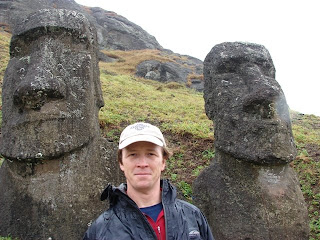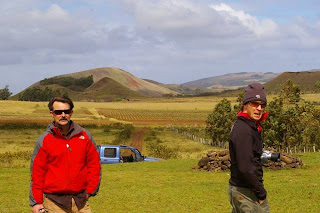 This expedition was also approved as an Explorers Club Flag Expedition. From left to right, Knutt Peterson, me, Sergio Rapu (Chief Archaeologist of Rapa Nui), Pete Polsgrove, Christina Colpitts and Dan Ruby.
This expedition was also approved as an Explorers Club Flag Expedition. From left to right, Knutt Peterson, me, Sergio Rapu (Chief Archaeologist of Rapa Nui), Pete Polsgrove, Christina Colpitts and Dan Ruby. Last night, we went to a Te Ra’ai, a restaurant that hosts a traditional Rapa Nui celebration. We were entertained with dancing and music from both Rapa Nui, as well as elsewhere in Polynesia, and we had a traditional Rapa Nui feast. We had three types of fish, chicken and steak cooked in the ground using heated basalt stones and overlaid with banana leaves. I'm having my face painted using traditional paints -- a custom on the island. Credit: Dan Ruby.
Last night, we went to a Te Ra’ai, a restaurant that hosts a traditional Rapa Nui celebration. We were entertained with dancing and music from both Rapa Nui, as well as elsewhere in Polynesia, and we had a traditional Rapa Nui feast. We had three types of fish, chicken and steak cooked in the ground using heated basalt stones and overlaid with banana leaves. I'm having my face painted using traditional paints -- a custom on the island. Credit: Dan Ruby.Today was our last field day on Rapa Nui. This project resulted in several important milestones. First, we conducted the first cave biodiversity inventory on the island. We sampled one large cave, which was separated by a series of collapse pits for both invertebrates, vertebrate sign, and microbes.
 Our "last" approach to one of our study sites. Credit: Dan Ruby.
Our "last" approach to one of our study sites. Credit: Dan Ruby.Secondly, we sampled two fern/moss gardens in the vicinity of our study cave. In addition to cave deep zones, this may prove to be another important aspect of this research. While completing and ultimately expanding upon the cave biodiversity inventories will be vitally important to developing a better understanding of Rapa Nui natural history, both caves and fern/moss gardens may serve as relict ecotones. As I mentioned in a previous blog, the island was dramatically changed by an extended period of severe deforestation and habitat alteration. This resulted in most of the native and endemic plants and animals being driven to extinction. Caves are probably buffered environments here.
 The team doing various things related to the invertebrate survey. The "yellow ghost" is Christina. She found this method most effective at keeping the paperwork dry. Credit: Pete Polsgrove.
The team doing various things related to the invertebrate survey. The "yellow ghost" is Christina. She found this method most effective at keeping the paperwork dry. Credit: Pete Polsgrove. Dan conducting a time-constrained search for invertebrates while on his sampling station. Credit: Pete Polsgrove.
Dan conducting a time-constrained search for invertebrates while on his sampling station. Credit: Pete Polsgrove.Third, we collected numerous microbe samples from both the cave entrances and deep zone. Currently, the only microbe known from this island is Rapamicne. This is a microbe essentially pilfered from the island by a team of Canadian researchers back in the mid-1960s. Rapamicne is used today to help kidney transplant patients to better acceptance the transplanted organ. We do not know whether this work will render similar finds significant to medicine; however, this is an area that we will be investigating when the cultures from these microbes are grown and they are studied. If something significant is discovered, the findings will become the sole property of the Rapa Nui people.
 Christina and I collecting invertebrates. Credit: Pete Polsgrove.
Christina and I collecting invertebrates. Credit: Pete Polsgrove.Forth, Knutt essentially mapped his first cave solo. He had about 20 minutes of help towards the end just to speed up the process. This map will contain all archaeological finds encountered, as well as plots of our invertebrate/ microbe sample locations.
 Biofilms on the cave wall. These as well as numerous other bacteria samples were collected during this work. Credit: Pete Polsgrove.
Biofilms on the cave wall. These as well as numerous other bacteria samples were collected during this work. Credit: Pete Polsgrove.Finally, we likely discovered the first cave-adapted/ limited species on the island. The millipede discovered on decomposing wood in a cave deep zone will likely be very important for this project, as well as future research here. This lends further weight to the high probability that caves were indeed buffered environments and may represent one of the only relict ecosystems on Rapa Nui.
 Pete collecting pH readings near one of the microbe sample sites. Credit: Dan Ruby.
Pete collecting pH readings near one of the microbe sample sites. Credit: Dan Ruby. Roaches in one of our traps. Roaches are quite common in Rapa Nui caves. As one might expect, they are also quite common on the surface. Credit: Dan Ruby.
Roaches in one of our traps. Roaches are quite common in Rapa Nui caves. As one might expect, they are also quite common on the surface. Credit: Dan Ruby.So, we are all very pleased with our discoveries and the work we have completed. We leave for the Continent tomorrow, and then everyone but Christina will arrive in the states on 23 August. Christina will remain for another week. She will be visiting friends in Santiago.
 Pushing through a tight passage modified by the ancient Rapa Nui. These tight passages were "checkpoints" within the cave. A foe would have to move slowly through this area. If they were detected, someone may be waiting for them on the other end to bludgeon them to death. Fortunately, it was just Dan. Credit: Dan Ruby.
Pushing through a tight passage modified by the ancient Rapa Nui. These tight passages were "checkpoints" within the cave. A foe would have to move slowly through this area. If they were detected, someone may be waiting for them on the other end to bludgeon them to death. Fortunately, it was just Dan. Credit: Dan Ruby.Chile and Rapa Nui have provided me with many learning and growing experiences. I will leave Rapa Nui as a seasoned expedition leader with two major expeditions under belt. My team has also taught me much. In particular, I have learned to let go of many aspects of this project and permit this group of incredibly bright individuals to help me execute a significant portion of the tasks associated with daily operations. This has always been hard for me.
While in many ways I am looking forward to returning to my Flagstaff home, I will miss Rapa Nui immensely. I am already looking forward to my return here in November.
 Searching for invertebrates in a moss/ fern garden. Credit: Dan Ruby.
Searching for invertebrates in a moss/ fern garden. Credit: Dan Ruby.












































